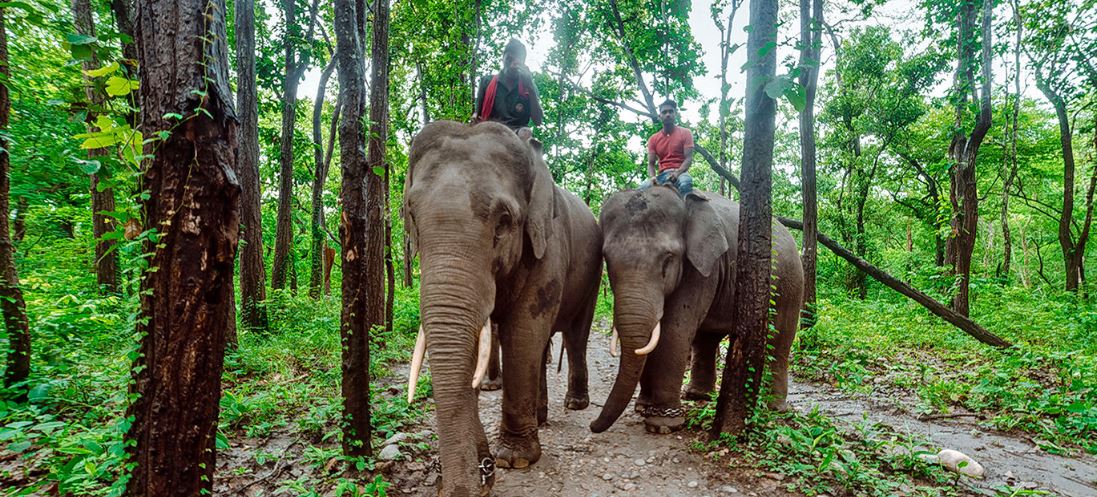Guide to Know Valmiki National Park & Tiger Reserve

Situated in the West Champaran district of Bihar, Valmiki National Park spans over an area of approximately 900 square kilometres. It is nestled in the foothills of the Himalayas and is bordered by Nepal on three sides. The park is renowned for its rich biodiversity, encompassing a variety of flora and fauna. It is home to diverse ecosystems including tropical forests, grasslands and riverine habitats. The park serves as a crucial habitat for several endangered species including the Bengal tiger, Indian rhinoceros, Asiatic elephant and Gangetic dolphin. Valmiki National Park stands as a significant ecological asset contributing to the conservation of India's natural heritage and providing a sanctuary for a diverse range of wildlife species.
Early History of Valmiki Tiger Reserve
The early history of Valmiki Tiger Reserve is intertwined with the rich cultural and ecological heritage of the region. The region around Valmiki Tiger Reserve has a long history dating back to ancient and medieval times. It is believed to have been inhabited by various indigenous communities and was part of the cultural and trade networks of ancient India. The name "Valmiki" is derived from the legend of Maharishi Valmiki, the author of the ancient Indian epic, the Ramayana. According to legend, Maharishi Valmiki had his ashram (hermitage) in this region, where he composed the epic. The area holds cultural significance due to its association with this revered sage. The modern history of Valmiki Tiger Reserve begins with the establishment of Valmiki Wildlife Sanctuary in 1976. Initially, it was designated as a wildlife sanctuary to protect the diverse flora and fauna of the region, including its tiger population. In 1990, Valmiki Wildlife Sanctuary was upgraded to a tiger reserve under India's Project Tiger initiative. This upgrade aimed to provide enhanced protection to the endangered Bengal tiger and its habitat within the sanctuary.
What to do in Valmiki Tiger Reserve?
Jungle Safari in Valimiki: Jungle safari in Valmiki Tiger Reserve offers an exhilarating opportunity to explore the wilderness and observe its diverse flora and fauna in their natural habitat. The tiger reserve is divided into designated safari zones where visitors can embark on guided safari tours. These zones are carefully chosen to maximize the chances of spotting wildlife while ensuring minimal disturbance to their natural environment. Valmiki Tiger Reserve is home to a wide variety of wildlife, including Bengal tigers, Indian rhinoceroses, Asiatic elephants, leopards, sloth bears, deer species, wild boars, and numerous bird species. During the safari, visitors have the opportunity to spot these magnificent creatures in their natural habitat, making for an unforgettable wildlife viewing experience. Jeep Safaris in Valmiki National Park offer ample opportunities for photography and videography enthusiasts to capture stunning images and footage of wildlife, landscapes, and unique moments encountered during the tour.
Places to Visit Nearby
- Kesaria Stupa is located approximately 45 kilometres from Valmiki Tiger Reserve, it is one of the tallest and largest Buddhist stupas in the world. Dating back to the 6th century AD, this ancient monument is a significant pilgrimage site for Buddhists and showcases remarkable architectural craftsmanship.
- Narkatiaganj is situated about 30 kilometers from Valmiki Tiger Reserve, is a town steeped in history and cultural heritage. It is known for its colonial-era buildings, including the Narkatiaganj Court, Church of North India, and Narkatiaganj Railway Station which reflect its colonial past.
- Bagaha is located around 50 kilometers from Valmiki Tiger Reserve, is a town known for its religious sites and natural beauty. The Bagaha Math, dedicated to Lord Shiva attracts pilgrims from far and wide. The town is also surrounded by lush greenery and offers opportunities for nature walks and birdwatching.
- Lauria Nandangarh is about 70 kilometers from Valmiki Tiger Reserve lies Lauria Nandangarh, an archaeological site famous for its ancient Ashoka Pillar. Dating back to the 3rd century BC, the pillar is adorned with inscriptions and carvings depicting Ashoka's edicts and is a UNESCO World Heritage Site.
- Ramnagar is located approximately 60 kilometres from Valmiki Tiger Reserve is a town known for its historical significance and natural beauty. It is home to Ramnagar Fort, a magnificent structure built during the Mughal era, and offers picturesque views of the surrounding landscape.
- Bhitiharwa Ashram is situated around 40 kilometres from Valmiki Tiger Reserve, Bhitiharwa Ashram is a serene retreat nestled amidst lush greenery. Founded by Swami Sahajanand Saraswati, this ashram serves as a centre for spiritual learning and meditation.